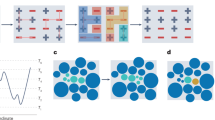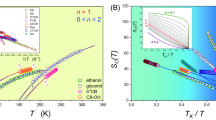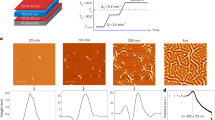Abstract
Supercooled liquids exhibit a pronounced slowdown of their dynamics on cooling1 without showing any obvious structural or thermodynamic changes2. Several theories relate this slowdown to increasing spatial correlations3,4,5,6. However, no sign of this is seen in standard static correlation functions, despite indirect evidence from considering specific heat7 and linear dielectric susceptibility8. Whereas the dynamic correlation function progressively becomes more non-exponential as the temperature is reduced, so far no similar signature has been found in static correlations that can distinguish qualitatively between a high-temperature and a deeply supercooled glass-forming liquid in equilibrium. Here, we show evidence of a qualitative thermodynamic signature that differentiates between the two. We show by numerical simulations with fixed boundary conditions that the influence of the boundary propagates into the bulk over increasing length scales on cooling. With the increase of this static correlation length, the influence of the boundary decays non-exponentially. Such long-range susceptibility to boundary conditions is expected within the random first-order theory4,9,10 (RFOT) of the glass transition. However, a quantitative account of our numerical results requires a generalization of RFOT, taking into account surface tension fluctuations between states.
This is a preview of subscription content, access via your institution
Access options
Subscribe to this journal
Receive 12 print issues and online access
$259.00 per year
only $21.58 per issue
Buy this article
- Purchase on SpringerLink
- Instant access to full article PDF
Prices may be subject to local taxes which are calculated during checkout



Similar content being viewed by others
References
Ediger, M. D., Angell, C. A. & Nagel, S. R. Supercooled liquids and glasses. J. Phys. Chem. 100, 13200 (1996).
Leheny, R. L. et al. Structural studies of an organic liquid through the glass transition. J. Chem. Phys. 105, 7783–7794 (1996).
Gibbs, J. H. & DiMarzio, E. A. Nature of the glass transition and the glassy state. J. Chem. Phys. 28, 373–383 (1958).
Kirkpatrick, T. R., Thirumalai, D. & Wolynes, P. G. Scaling concepts for the dynamics of viscous liquids near an ideal glassy state. Phys. Rev. A 40, 1045–1054 (1989).
Garrahan, J. P. & Chandler, D. Geometrical explanation and scaling of dynamical heterogeneities in glass forming systems. Phys. Rev. Lett. 89, 035704 (2002).
Tarjus, G., Kivelson, S. A., Nussinov, Z. & Viot, P. The frustration-based approach of supercooled liquids and the glass transition: a review and critical assessment. J. Phys. Condens. Matter 17, R1143 (2005).
Fernández, L. A., Martín-Mayor, V. & Verrocchio, P. Critical behavior of the specific heat in glass formers. Phys. Rev. E 73, 020501 (2006).
Menon, N. & Nagel, S. R. Evidence for a divergent susceptibility at the glass transition. Phys. Rev. Lett. 74, 1230–1233 (1995).
Bouchaud, J.-P. & Biroli, G. On the Adam–Gibbs–Kirkpatrick–Thirumalai–Wolynes scenario for the viscosity increase in glasses. J. Chem. Phys. 121, 7347–7354 (2004).
Dzero, M., Schmalian, J. & Wolynes, P. G. Activated events in glasses: The structure of entropic droplets. Phys. Rev. B 72, 100201 (2005).
Montanari, A. & Semerjian, G. Rigorous inequalities between length and timescales in glassy systems. J. Stat. Phys. 125, 23–54 (2006).
Bouchaud, J.-P. & Biroli, G. Nonlinear susceptibility in glassy systems: A probe for cooperative dynamical length scales. Phys. Rev. B 72, 064204 (2005).
Coluzzi, B., Mezard, M., Parisi, G. & Verrocchio, P. Thermodynamics of binary mixture glasses. J. Chem. Phys. 111, 9039–9052 (1999).
Kivelson, D., Tarjus, G. & Kivelson, S. A. A viewpoint, model and theory for supercooled liquids. Prog. Theor. Phys. Suppl. 126, 289–299 (1997).
Toninelli, C., Biroli, G. & Fisher, D. S. Jamming percolation and glass transitions in lattice models. Phys. Rev. Lett. 96, 035702 (2006).
Ediger, M. D. Spatially heterogeneous dynamics in supercooled liquids. Annu. Rev. Phys. Chem. 51, 99–128 (2000).
Berthier, L. et al. Direct experimental evidence of a growing length scale accompanying the glass transition. Science 310, 1797–1800 (2005).
Toninelli, C., Wyart, M., Berthier, L., Biroli, G. & Bouchaud, J.-P. Dynamical susceptibility of glass formers: Contrasting the predictions of theoretical scenarios. Phys. Rev. E 71, 041505 (2005).
Scheidler, P., Kob, W. & Binder, K. The relaxation dynamics of a supercooled liquid confined by rough walls. J. Phys. Chem. B 108, 6673–6686 (2004).
Jack, R. L. & Garrahan, J. P. Caging and mosaic length scales in plaquette spin models of glasses. J. Chem. Phys. 123, 164508 (2005).
Cammarota, C. & Cavagna, A. A novel method for evaluating the critical nucleus and the surface tension in systems with first order phase transition. J. Chem. Phys. 127, 214703 (2007).
Franz, S. First steps of a nucleation theory in disordered systems. J. Stat. Mech. 2005, P04001 (2005).
Cavagna, A., Grigera, T. S. & Verrocchio, P. Mosaic multistate scenario versus one-state description of supercooled liquids. Phys. Rev. Lett. 98, 187801 (2007).
Bernu, B., Hansen, J. P., Hiwatari, Y. & Pastore, G. Soft-sphere model for the glass transition in binary alloys: Pair structure and self-diffusion. Phys. Rev. A 36, 4891–4903 (1987).
Roux, J.-N., Barrat, J.-L. & Hansen, J.-P. Dynamical diagnostics for the glass transition in soft-sphere alloys. J. Phys. Condens. Matter 1, 7171–7186 (1989).
Mézard, M. & Montanari, A. Reconstruction on trees and spin glass transition. J. Stat. Phys. 124, 1317–1350 (2006).
Franz, S. & Montanari, A. Analytic determination of dynamical and mosaic length scales in a Kac glass model. J. Phys. A 40, F251–F257 (2007).
Franz, S., Parisi, G. & Ricci-Tersenghi, F. Mosaic length and finite interaction-range effects in a one dimensional random energy model. Preprint at <http://arxiv.org/abs/0711.4780v2> (2007).
Adam, G. & Gibbs, J. H. On the temperature dependence of cooperative relaxation properties in glass-forming liquids. J. Chem. Phys. 43, 139–146 (1965).
Stevenson, J. D., Schmalian, J. & Wolynes, P. G. The shapes of cooperatively rearranging regions in glass-forming liquids. Nature Phys. 2, 268–274 (2006).
Moore, M. A. & Yeo, J. Thermodynamic glass transition in finite dimensions. Phys. Rev. Lett. 96, 095701 (2006).
Grigera, T. S. & Parisi, G. Fast Monte Carlo algorithm for supercooled soft spheres. Phys. Rev. E 63, 045102 (2001).
Acknowledgements
We thank C. Cammarota, L. A. Fernandez, G. Gradenigo, I. Giardina, A. Lefèvre, V. Martín-Mayor, A. Montanari, G. Parisi, D. Reichman, M. Tarzia and F. Zamponi for useful discussions. G.B. and J.-P.B. are supported by ANR Grant DYNHET. T.S.G. thanks ECT* and Dipartimento di Fisica, Universitá di Trento for hospitality and partial support and acknowledges partial support from CONICET and ANPCyT (Argentina) and ICTP (Trieste, Italy).
Author information
Authors and Affiliations
Corresponding author
Supplementary information
Supplementary Information
Supplementary Information (PDF 89 kb)
Rights and permissions
About this article
Cite this article
Biroli, G., Bouchaud, JP., Cavagna, A. et al. Thermodynamic signature of growing amorphous order in glass-forming liquids. Nature Phys 4, 771–775 (2008). https://doi.org/10.1038/nphys1050
Received:
Accepted:
Published:
Issue date:
DOI: https://doi.org/10.1038/nphys1050
This article is cited by
-
Modern computational studies of the glass transition
Nature Reviews Physics (2023)
-
Active topological glass
Nature Communications (2020)
-
Revealing key structural features hidden in liquids and glasses
Nature Reviews Physics (2019)
-
Zero-temperature glass transition in two dimensions
Nature Communications (2019)
-
Measurements of growing surface tension of amorphous–amorphous interfaces on approaching the colloidal glass transition
Nature Communications (2018)



